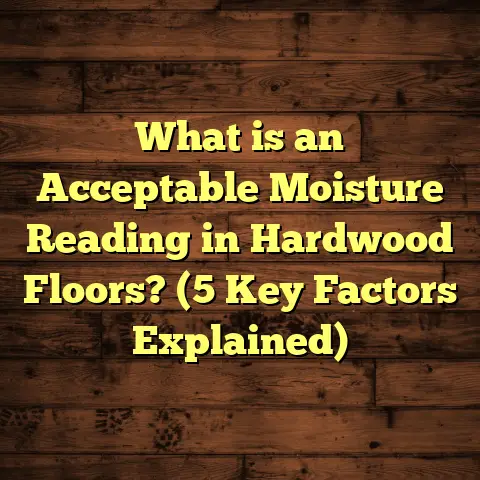What is Engineered White Oak Flooring? (5 Key Benefits Explained!)
Have you ever walked into a home or office and noticed the floor catching your eye—maybe it had the warm glow of natural wood but seemed more stable or modern? Maybe you wondered what kind of wood flooring it was and why it seemed different from the traditional hardwood floors you’re used to seeing. I’ve spent years in the flooring business, installing, repairing, and advising on countless flooring projects, and one option that keeps coming up as a favorite among homeowners and contractors alike is engineered white oak flooring.
Why? Because it combines the authentic beauty of real white oak with technical advantages that make it ideal for many situations where solid hardwood might fall short. I want to walk you through everything you need to know about engineered white oak flooring—what it is, why it’s so popular, its benefits, cost considerations, and even some real stories from my experience. By the end, you’ll have a clear picture of whether this flooring could be right for your space.
What Is Engineered White Oak Flooring?
Let’s start with the basics: what exactly is engineered white oak flooring?
Engineered wood flooring is a layered product designed for both beauty and durability. Unlike traditional solid hardwood planks that are made from a single piece of wood all the way through, engineered flooring consists of a top layer—called the veneer—made from real hardwood. In this case, that veneer is white oak. Underneath this layer are multiple layers of plywood or high-density fiberboard (HDF), glued together with grains running perpendicular to each other.
This cross-layer construction adds stability and strength that solid wood can’t always provide. It helps resist warping, cupping, and shrinking caused by changes in humidity or temperature.
White oak itself is a hardwood species well-known for its durability and distinct grain. It has a warm tone with some subtle golden hues and a slightly coarse texture. This makes it an excellent choice for flooring because it wears well and looks great over time.
Layer Structure Explained
In my work, I’ve seen engineered white oak flooring come in various thicknesses. Typically, the top veneer layer ranges from about 2mm (0.08 inches) up to 6mm (0.24 inches). Thicker veneers allow for more sanding and refinishing over time but cost more upfront.
Beneath the veneer are core layers made of plywood or HDF stacked in alternating grain directions. This means that if one layer expands in a certain direction due to moisture, the next layer pulls in the opposite direction, canceling out movement.
This is why engineered flooring is often better suited for areas like basements or kitchens where moisture levels fluctuate more than usual.
How Engineered White Oak Flooring Is Made
I once toured a flooring mill where they showed me how these floors are crafted:
- Veneer Slicing: A log of white oak is sliced into very thin sheets called veneer. This cutting technique preserves the natural grain pattern.
- Core Layer Preparation: Several layers of plywood or HDF are cut to size.
- Gluing and Pressing: The veneer is glued on top of the core layers, which are then pressed under high pressure to bond everything tightly.
- Cutting into Planks: The large sheets are cut into individual planks.
- Finishing: Many planks come prefinished with protective coats like aluminum oxide or UV-cured finishes.
This manufacturing process results in boards that look like solid wood but are more dimensionally stable.
Why I Often Recommend Engineered White Oak Flooring: 5 Key Benefits
Now that you know what it is, let’s talk about why so many homeowners, designers, and contractors—including myself—prefer engineered white oak flooring.
1. Better Stability in Varying Conditions
One of the biggest challenges with solid hardwood floors is their sensitivity to moisture and temperature changes. Wood naturally expands when it absorbs moisture and contracts when dry, which can cause warping, gaps, or buckling over time.
Engineered white oak flooring is designed to handle these changes much better because of its layered construction.
Data Insight: According to industry research, engineered hardwood floors expand about 50% less than solid wood when exposed to moisture changes. This means fewer worries about damage in kitchens, bathrooms, or basements.
I remember a client who installed solid oak hardwood in their home’s lower level only to find it buckled after one wet winter season. When they switched to engineered white oak on my recommendation during renovation, the floor held up beautifully for years without any issues.
2. Authentic Look and Feel of Real Wood
There’s simply no substitute for the natural beauty of real wood flooring. While laminate or vinyl options try to mimic wood grain patterns with prints or textures, they just don’t compare to genuine wood.
With engineered white oak flooring, the top layer is actual white oak harvested from trees. This means you get all the subtle grain variations, knots, and color shifts that make each plank unique.
From my installations, I’ve noticed many clients are surprised at how similar engineered white oak looks compared to solid planks—even seasoned wood floorers sometimes can’t tell the difference once it’s installed.
Plus, you can finish engineered white oak with stains or oils just like solid wood to further customize its look.
3. Easier Installation Saves Time and Costs
Compared to solid hardwood floors—which often require nails or staples—engineered white oak flooring offers multiple installation methods including click-lock floating floors, glue-down applications, or even nail-down in some cases.
This flexibility can reduce labor time significantly.
One tool that has helped me immensely on projects is FloorTally. It’s an online calculator that combines local labor rates, material costs, and waste factors to produce precise estimates before ordering materials or starting work.
For example, I had a project with an unusually shaped room full of corners and angles. FloorTally showed me exactly how much extra material would be needed due to waste from cuts. Without it, I might have underestimated and caused delays waiting for more flooring boards to arrive.
4. Long-Lasting Durability
White oak ranks high on hardness scales used by flooring experts. On the Janka hardness test (which measures resistance to denting), white oak scores around 1,360 lbf (pounds-force), making it harder than many other common hardwoods like red oak or maple.
When combined with the engineered construction method, this translates into floors that hold up well against foot traffic, pets, furniture movement, and everyday wear.
In my experience installing floors in busy homes and commercial spaces like cafes or boutiques, engineered white oak has proven resilient with only occasional refinishing needed after years of use.
5. More Environmentally Friendly Choice
Using engineered white oak flooring can be more sustainable than solid hardwood because less slow-growing hardwood is required per plank. Only a thin veneer layer is real hardwood; the core layers are made from faster-growing plywood or HDF.
Many manufacturers also source wood from certified forests managed responsibly to support forest health.
Personally, I always ask clients if sustainability matters to them before recommending products. Certified engineered white oak floors offer peace of mind if you want beautiful floors without compromising your environmental values.
Diving Deeper: How Engineered White Oak Performs in Different Environments
You might be wondering: “Is this floor right for my specific room?” Over the years, I’ve installed engineered white oak in various settings—each teaching me something new about its performance.
Basement Installations
Basements pose a challenge due to high humidity and potential water issues. Solid hardwood rarely works well here because it absorbs moisture unevenly and warps quickly.
Engineered white oak handles basements better because its cross-ply core stabilizes movement caused by moisture shifts.
One basement project I worked on included installing a vapor barrier beneath the floor along with engineered white oak boards. After two years, the client reported no swelling or warping despite occasional dampness in the room.
Kitchens and Bathrooms
While tile dominates wet areas like bathrooms due to water resistance, some people want warmer wood tones in kitchens or powder rooms.
Engineered white oak can tolerate higher moisture levels than solid hardwood but still needs proper sealing and maintenance.
Pro tip: Use water-resistant finishes and wipe up spills immediately to protect your floor’s surface.
Living Rooms and High-Traffic Areas
In family rooms or entryways where traffic is heavy, durability is key. Engineered white oak’s hardness rating makes it perfect for these spaces.
I’ve seen floors maintain their sheen even after years of kids running around or pets scratching at doors.
Maintenance Tips That Keep Your Engineered White Oak Flooring Looking Great
One question I often get: “How do I care for my engineered wood floor so it lasts?”
Here’s what I tell friends and clients:
- Regular Cleaning: Sweep or vacuum weekly to remove dirt particles that can scratch the finish.
- Use Soft Cleaning Products: Avoid harsh chemicals; instead opt for cleaners labeled safe for hardwood floors.
- Protect from Water: Quickly wipe spills; don’t let liquids pool on your floor.
- Furniture Pads: Attach felt pads under chair legs and furniture to prevent dents.
- Humidity Control: Keep indoor humidity between 35-55% using humidifiers/dehumidifiers if necessary.
- Refinishing When Needed: Depending on veneer thickness, you can sand and refinish your floor once or twice over its life (usually after 10+ years).
Costs: What You Should Know Before Buying
Budgeting for new floors can be stressful if you don’t have all the facts upfront.
Material Cost Range: Engineered white oak usually costs between $5–$12 per square foot depending on quality and veneer thickness.
Installation Labor: Labor varies widely based on location but expect $3–$8/sq ft for professional installation.
Additional Costs: Don’t forget underlayment ($0.50–$1/sq ft), removal of old floors if needed ($1–$3/sq ft), and delivery fees.
Using tools like FloorTally helps me combine all these variables into one estimate tailored for each project location and size.
For example: For a 1,000 sq ft room in a mid-sized city with average labor costs, FloorTally estimated total installed cost at around $10–$14 per square foot including waste factor allowances—helping my client set realistic expectations early on.
Personal Stories That Shaped My Views on Engineered White Oak
Every project teaches me something new about this flooring type:
- A newlywed couple wanted floors that would last through kids and pets without constant repairs. Engineered white oak gave them peace of mind plus natural beauty.
- A boutique owner chose this flooring for its classy look but also needed durability for daily customer traffic.
- One family used FloorTally estimates to justify upgrading their budget slightly because they saw how higher-quality veneer extended floor life significantly over cheaper alternatives.
Final Thoughts: Why Engineered White Oak Could Be Your Best Flooring Choice
If you want floors that combine timeless beauty with modern durability, engineered white oak deserves serious thought.
It suits many rooms—even tricky ones like basements—offers easier installation options, holds up well over time, and can be more eco-friendly than solid hardwood alternatives.
If you want help deciding whether engineered white oak fits your style or budget, just reach out—I’m happy to share what works best based on your unique needs!
Got questions? Let’s talk!





